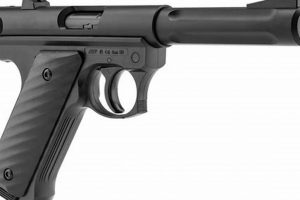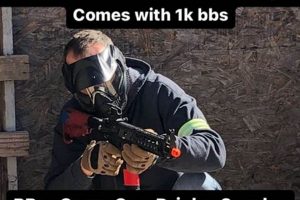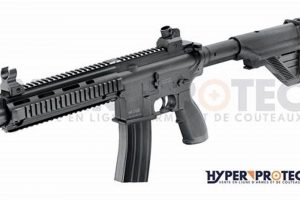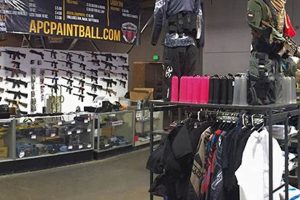These events are a subset of the broader airsoft hobby, distinguished by their focus on simulating realistic military operations. Participants utilize airsoft replicas of real-world firearms and tactical gear to engage in scenarios that often mimic actual combat situations. An example would be a weekend-long event where players are assigned to specific factions with objectives to capture territory, secure intelligence, or eliminate opposing forces, adhering to a complex set of rules and engagement protocols.
The significance of these simulations lies in their ability to provide a challenging and immersive experience that promotes teamwork, strategic thinking, and physical endurance. Participants develop leadership skills, learn to communicate effectively under pressure, and gain a greater appreciation for the complexities of military tactics. Historically, the growth of this segment of airsoft reflects a broader cultural interest in military realism and the desire for engaging, participatory forms of entertainment.
The following sections will delve into the specific aspects of these immersive events, examining topics such as equipment requirements, gameplay mechanics, organizational structures, and the evolving trends within the community. Further discussion will highlight the safety considerations and ethical guidelines that govern responsible participation.
Tactical Recommendations for Enhanced Airsoft Milsim Participation
This section offers guidance designed to optimize engagement within airsoft milsim events. Each recommendation emphasizes preparation, teamwork, and adherence to established protocols.
Tip 1: Prioritize Physical Conditioning: Adequate physical fitness is paramount. Milsim events frequently involve prolonged periods of movement across varied terrain. Consistent cardiovascular exercise and strength training can significantly improve endurance and reduce the risk of injury.
Tip 2: Master Communication Protocols: Effective communication is crucial for mission success. Familiarize oneself with established radio procedures, including call signs, brevity codes, and emergency protocols. Practice clear and concise communication techniques.
Tip 3: Conduct Thorough Gear Inspection: Prior to any event, a meticulous inspection of all equipment is necessary. Ensure airsoft replicas are properly maintained, batteries are fully charged, and tactical gear is correctly fitted. Malfunctions can severely hinder performance.
Tip 4: Emphasize Teamwork and Coordination: Individual skill is secondary to effective teamwork. Develop a clear understanding of assigned roles and responsibilities. Practice coordinated movement and communication with fellow team members.
Tip 5: Study the Operational Environment: Acquire detailed knowledge of the event’s operating area. Review maps, aerial photographs, and intelligence briefings to identify key terrain features, potential hazards, and strategic objectives.
Tip 6: Implement Sound Tactical Doctrine: Ground movements, weapon handling, and decision making should be based on fundamental military doctrines. Cover and concealment should be emphasized, and fire team integrity preserved.
Tip 7: Hydration and Nutrition: Sustained physical activity requires sufficient hydration and appropriate nutritional intake. Carry an adequate supply of water and nutrient-rich snacks to maintain energy levels throughout the event.
Adhering to these recommendations will contribute to enhanced individual performance and overall team effectiveness within airsoft milsim environments. Disciplined execution of these principles will facilitate a more immersive and rewarding experience.
The subsequent sections will explore advanced strategies and organizational considerations essential for long-term engagement with the airsoft milsim community.
1. Realism
Realism serves as a foundational principle in airsoft milsims, differentiating them from standard airsoft games. The degree of fidelity to actual military procedures, equipment, and scenarios directly influences the immersive quality and perceived value of the experience.
- Weapon Handling and Simulation
This aspect involves replicating the functionality, weight, and handling characteristics of real firearms within the constraints of airsoft technology. For instance, airsoft replicas may feature realistic magazine capacities, recoil simulation, and require similar reloading procedures. Implementing these details elevates the sense of authenticity and forces participants to employ proper weapon discipline.
- Tactical Doctrine and Maneuvers
Milsims frequently incorporate established military tactics, techniques, and procedures (TTPs). Participants may be required to utilize formations, communication protocols, and fire and maneuver strategies mirroring those used by actual armed forces. This inclusion necessitates knowledge of tactical principles and the ability to adapt them to the airsoft environment.
- Equipment and Loadout Authenticity
The use of authentic military-style equipment, such as uniforms, load-bearing gear, and communication systems, contributes significantly to the overall realism. Participants often strive to replicate specific military units or historical loadouts. This attention to detail extends beyond aesthetics, impacting functionality and forcing participants to consider the practical limitations of their gear.
- Scenario Design and Objective-Based Gameplay
Milsim scenarios are often structured around realistic military objectives, such as reconnaissance, search and destroy missions, or defensive operations. The scenarios may be based on historical events or contemporary conflicts. This framework provides a context for participant actions and reinforces the importance of strategic planning and coordinated execution.
The pursuit of realism in airsoft milsims is not merely about imitation; it is about creating an environment where participants can test their skills, learn about military operations, and appreciate the complexities of tactical decision-making. By striving for accuracy in weapon handling, tactical doctrine, equipment, and scenario design, milsims offer a unique and engaging experience that transcends the limitations of traditional airsoft gameplay.
2. Teamwork
Teamwork forms the bedrock of successful airsoft milsim operations. The highly structured and objective-oriented nature of these events necessitates coordinated action and mutual reliance among participants. Without cohesive teamwork, the simulated combat environment presents insurmountable challenges.
- Shared Objectives and Coordination
Milsims typically involve complex objectives that require the combined efforts of multiple individuals. Success hinges on a clear understanding of the mission goals and the ability to coordinate movements, communications, and tactical maneuvers to achieve those goals. Teams must work in unison, anticipating each other’s actions and adapting to changing circumstances.
- Communication and Information Sharing
Effective communication is paramount in any team-based activity, and particularly critical in the dynamic environment of airsoft milsims. Clear and concise communication ensures that information is disseminated quickly and accurately, enabling timely responses to emerging threats and opportunities. Pre-established communication protocols and the use of tactical radios are essential for maintaining situational awareness and coordinating actions.
- Role Specialization and Task Assignment
Efficient teamwork often involves the specialization of roles, with each participant contributing unique skills and expertise to the overall effort. Within a milsim squad, individuals may be assigned roles such as rifleman, medic, grenadier, or team leader. Proper task assignment ensures that all necessary functions are covered and that each member contributes optimally to the team’s success. Clear understanding of each others roles in the squad is necessary as well.
- Leadership and Decision-Making
Strong leadership is crucial for guiding team actions and making informed decisions under pressure. Leaders must be able to assess the situation, formulate plans, and effectively communicate instructions to their subordinates. Effective leadership fosters trust and cohesion within the team, enabling them to overcome obstacles and achieve their objectives.
The interplay of these elements underscores the vital role of teamwork in airsoft milsims. Participants must embrace collaboration, communication, and mutual support to navigate the challenges and achieve success in the simulated combat environment. The level of teamwork exhibited directly correlates with the overall effectiveness and enjoyment of the milsim experience.
3. Strategy
Strategy is an indispensable component of airsoft milsims, serving as the framework upon which tactical decisions and operational execution are built. The implementation of well-defined strategies differentiates these simulated combat scenarios from less structured airsoft games, elevating the experience to one demanding foresight, planning, and adaptability. The cause-and-effect relationship between strategic formulation and mission outcome is direct; a meticulously crafted strategy significantly increases the likelihood of achieving objectives, while a poorly conceived or absent strategy often results in failure and fragmentation of effort. The importance of strategy within airsoft milsims is analogous to its role in real-world military operations, where strategic planning dictates resource allocation, troop deployment, and overall campaign direction. For example, a strategy centered on aggressive, frontal assaults might be effective against poorly defended positions but could prove disastrous against a well-entrenched enemy force. Conversely, a strategy emphasizing reconnaissance, flanking maneuvers, and coordinated ambushes might be more successful in overcoming superior numbers or fortified defenses.
Practical application of strategic thinking within airsoft milsims extends beyond simply formulating a plan. It necessitates effective communication of the strategy to all participants, ensuring that each individual understands their role and responsibilities within the larger framework. Furthermore, it demands the ability to adapt the strategy in response to unforeseen circumstances or changes in the operational environment. For instance, if a key objective is compromised early in a scenario, the strategic plan must be revised to accommodate the loss and refocus efforts on alternative objectives. This requires a high degree of flexibility and the ability to think critically under pressure. Moreover, understanding the opponent’s likely strategies is crucial. Identifying potential enemy tactics and developing countermeasures is a key element of effective strategic planning. This might involve anticipating ambush locations, identifying key lines of communication, or predicting enemy reinforcement patterns.
In conclusion, strategy is not merely an abstract concept within airsoft milsims; it is a practical necessity that directly influences success or failure. Mastering strategic thinking, planning, and adaptation is essential for participants seeking to excel in these challenging simulated combat environments. The challenges inherent in developing and executing effective strategies highlight the complex interplay of various factors, including terrain, equipment, personnel capabilities, and enemy actions. By embracing strategic thinking, participants can enhance their individual and team performance, contributing to a more immersive and rewarding overall milsim experience. The understanding of strategic principles learned within this context may extend beyond the game, improving planning and problem-solving skills in various aspects of life.
4. Equipment
The selection and utilization of equipment are integral to the realism and effectiveness of airsoft milsims. The correlation between the quality and appropriateness of the gear employed directly impacts a participant’s ability to execute tactical maneuvers, maintain situational awareness, and ultimately contribute to mission success. Inadequate or inappropriate equipment can hinder mobility, compromise communication, and diminish overall performance, undermining the immersive and challenging nature of the event. For instance, using a low-quality airsoft replica with inconsistent firing performance can negate the strategic advantages gained through careful planning and tactical positioning. Similarly, lacking proper load-bearing equipment can lead to fatigue and reduced maneuverability, making it difficult to maintain pace with the team or effectively engage the opposing force.
Practical significance of understanding equipment extends to considerations of authenticity and functional compatibility. Participants often strive to replicate the loadouts of specific military units or historical periods, which necessitates careful research and selection of gear that accurately reflects the chosen impression. However, authenticity must be balanced with practical considerations, such as comfort, durability, and compatibility with the airsoft environment. For example, while a vintage military radio might enhance the aesthetic appeal of a loadout, it may lack the range or reliability required for effective communication during a milsim event. Similarly, certain types of camouflage patterns may be highly effective in specific terrains but provide little concealment in other environments. Careful planning is necessary to balance realistic requirements with equipment.
In conclusion, equipment is more than mere adornment within airsoft milsims; it is a critical component that directly influences performance and immersion. The challenge lies in selecting gear that balances authenticity with practicality, enabling participants to effectively execute tactical maneuvers, maintain situational awareness, and contribute to the overall success of the mission. A thorough understanding of equipment options, coupled with careful planning and attention to detail, is essential for maximizing the airsoft milsim experience. Neglecting the importance of appropriately equipped teams leads to decreased operational effectiveness.
5. Communication
Communication within airsoft milsims serves as the central nervous system of coordinated operations. Its effectiveness dictates situational awareness, response times, and ultimately, mission success. The simulated combat environment necessitates a robust and well-defined communication infrastructure to overcome the inherent challenges of dispersed teams and dynamic scenarios.
- Radio Protocols and Discipline
Standardized radio protocols are essential for clear and efficient communication. Brevity codes, call signs, and pre-established frequencies minimize ambiguity and ensure that messages are transmitted and received accurately. Radio discipline, including limiting unnecessary chatter and adhering to established procedures, is crucial for maintaining communication integrity and preventing interference. Example protocols are usage of specific callsigns for squad leaders, usage of specific phrase to show the status of squad member. Failure to maintain radio discipline can lead to information overload, missed messages, and compromised situational awareness.
- Information Dissemination and Situational Awareness
Effective communication facilitates the rapid dissemination of critical information, enabling teams to maintain situational awareness. Real-time updates on enemy positions, changes in objectives, and emerging threats are essential for making informed tactical decisions. The ability to quickly relay and interpret information is a key determinant of success in a dynamic combat environment. For example, spot reports from forward observers provide crucial intelligence for planning ambushes or coordinating flanking maneuvers.
- Command and Control Structures
Airsoft milsims often replicate military command and control structures, establishing a clear chain of authority and responsibility. Effective communication is essential for maintaining command cohesion and ensuring that orders are transmitted and executed efficiently. Command and control structures provide a framework for decision-making and ensure that actions are aligned with overall strategic objectives. For instance, a squad leader may use radio communication to relay orders from the platoon commander to the individual fire teams within the squad. This enables centralized command and decentralized execution.
- Non-Verbal Communication and Signals
In situations where radio communication is compromised or impractical, non-verbal communication becomes essential. Hand signals, visual cues, and pre-arranged movements can be used to convey information silently and discreetly. Non-verbal communication requires a high degree of training and coordination, but it can provide a significant advantage in stealth operations or close-quarters combat. Common signals include “move up,” “enemy sighted,” and “danger zone.”
The various facets of communication within airsoft milsims highlight its critical role in orchestrating coordinated action and achieving mission objectives. From standardized radio protocols to non-verbal signaling, effective communication ensures that teams can maintain situational awareness, respond to threats, and operate cohesively in a simulated combat environment. The proficiency and effectiveness of communication directly correlate with the overall success and realism of the milsim experience.
6. Safety
The integration of stringent safety protocols is paramount within airsoft milsims, directly influencing participant well-being and the overall integrity of the simulated combat environment. The inherent risks associated with simulated combat, including projectile impacts, physical exertion, and environmental hazards, necessitate comprehensive safety measures to mitigate potential harm. The failure to prioritize safety can result in injuries, ranging from minor abrasions to more severe traumas, jeopardizing participant health and undermining the credibility of the event. A real-world example is the mandatory use of full-seal eye protection at all times on the field. This reduces the risk of eye injuries resulting from BB impacts. Consistent enforcement of velocity limits for airsoft replicas minimizes the potential for serious injury. The practical significance lies in creating a secure environment where participants can engage in realistic simulations without undue risk.
Enforcement mechanisms for safety protocols typically include pre-event briefings, equipment inspections, and on-field monitoring by designated safety personnel. Briefings cover rules of engagement, emergency procedures, and hazard awareness, ensuring that all participants are informed and prepared. Equipment inspections verify compliance with safety regulations, such as velocity limits and the use of approved protective gear. On-field monitoring allows safety personnel to identify and address potential hazards in real-time, such as unsafe behavior or environmental risks. Medical support must be readily available on site, with first aid trained personnel, at minimum. These actions ensure timely response to any injuries incurred by players during game play. Such measures collectively serve to minimize the likelihood of accidents and ensure a swift and effective response in the event of an incident.
In conclusion, safety is not merely a peripheral consideration within airsoft milsims; it is a fundamental imperative that shapes event design, participant conduct, and organizational responsibility. Maintaining a strong emphasis on safety requires ongoing vigilance, proactive risk management, and a commitment to continuous improvement. While challenges may arise in balancing realism with safety, prioritizing participant well-being remains the ultimate objective. The long-term success and sustainability of airsoft milsims depend on fostering a culture of safety that promotes responsible participation and minimizes the potential for harm.
Frequently Asked Questions About Airsoft Milsims
This section addresses common inquiries regarding airsoft milsims, providing clarification on fundamental aspects and dispelling potential misconceptions.
Question 1: What distinguishes airsoft milsims from standard airsoft skirmishes?
Airsoft milsims differentiate themselves through a concentrated emphasis on realism, encompassing tactical procedures, equipment usage, and objective-driven gameplay that often emulate actual military operations. Standard airsoft skirmishes typically prioritize fast-paced action with less regard for tactical authenticity.
Question 2: What level of prior experience is necessary to participate in airsoft milsims?
While prior airsoft experience can be beneficial, it is not always mandatory. A willingness to learn, adhere to instructions, and prioritize teamwork are often more crucial attributes. Many events offer introductory sessions for newcomers to familiarize themselves with basic tactics and safety protocols.
Question 3: What are the essential equipment requirements for engaging in airsoft milsims?
Essential equipment typically includes a suitable airsoft replica, full-seal eye protection, appropriate tactical attire, and a reliable communication device. Specific requirements may vary depending on the event and the chosen role within a team.
Question 4: Are airsoft milsims physically demanding?
Yes, airsoft milsims can be physically demanding, often involving prolonged periods of movement across varied terrain. Participants should possess a reasonable level of physical fitness to ensure they can safely and effectively participate in the event.
Question 5: What safety protocols are implemented during airsoft milsims?
Stringent safety protocols are enforced, including mandatory eye protection, velocity limits for airsoft replicas, and comprehensive pre-event briefings. On-field marshals monitor gameplay to ensure compliance and address any potential safety concerns.
Question 6: What are the ethical considerations within airsoft milsims?
Ethical conduct includes respecting game rules, adhering to the spirit of fair play, and demonstrating responsible gun handling. Honest reporting of hits, avoiding excessive force, and respecting the property of others are paramount.
Understanding these key aspects will contribute to a more informed and rewarding participation in airsoft milsim events.
The following section will explore the future trends and potential advancements within the airsoft milsim community.
Conclusion
The preceding analysis has examined the core dimensions of airsoft milsims, from the foundational principles of realism, teamwork, and strategy to the critical importance of equipment, communication, and safety. This exploration reveals a complex and multifaceted activity that extends beyond mere recreational engagement, presenting participants with opportunities for skill development, tactical learning, and immersive simulation.
The continued evolution of airsoft milsims will likely be shaped by advancements in technology, increased emphasis on realistic training methodologies, and the growing demand for engaging and participatory forms of entertainment. As the community expands, maintaining a commitment to safety, ethical conduct, and continuous improvement will be crucial for ensuring the long-term viability and integrity of airsoft milsims. Further research and development of new training scenarios may allow this hobby to be useful for military or law enforcement training.



![Dominate Airsoft: Best Uniform Set [Gear Guide] Ultimate Airsoft Guide for Beginners, Tactics & Gear Reviews Dominate Airsoft: Best Uniform Set [Gear Guide] | Ultimate Airsoft Guide for Beginners, Tactics & Gear Reviews](https://airsoftica.com/wp-content/uploads/2025/11/th-818-300x200.jpg)



